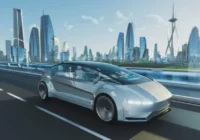Throughout history, technological advancements and mobility have been mutually reinforcing. In light of the Autonomous e-Mobility Forum in Qatar, we reflect on the trajectory of mobility over the last millennia. From the simplicity of footways to the complexity of electric travel and interconnected transportation systems, each era has contributed to our current standing.
This is the second of a three-part series, which sheds light on the evolution of mobility through distinct periods: ancient history, ending at the 18th century; the industrial age, leading up to current technologies and the era of artificial intelligence and driverless e-mobility.
Pre-Industrial Revolution developments
Before the Industrial Revolution, transportation advances primarily focused on enhancing ships’ strength and speed. Land travel improved with bridge and road construction. In the 7th century, the streets of Baghdad, Iraq, became the first to be paved with tar. Despite such improvements, land transport remained limited by animals’ footspeed; they were the only motive force.
In the 9th century, the Arab invention of the kamal enabled latitude navigation, which improved travel accuracy. The compass, first mentioned in a Chinese text written in 1044, aided navigation on both land and sea.
In the 14th and 15th centuries, significant investments funded voyages to discover new trade routes and territories. These led to the development of the first accurate world maps, such as the Mercator map of 1569. Maritime navigation advancements prompted the growth of global trade routes with profound impact, as mercantilism evolved into imperialism in the 16th and 17th centuries.
The Industrial Revolution and mobility innovation
The Industrial Revolution sparked mobility transformation, with the early phases continuing the reliance on water transport. Canal Mania in the UK saw the construction of over 4,000 miles of canals from 1790 to 1810. These enabled quicker and cheaper transportation of goods.
Inventor James Watt’s new steam engine design increased steam power efficiency. It was originally designed for use in factories, but it quickly unleashed the era of engine-powered mobility in the early 19th century. Steam-powered automobiles, ships and locomotives dramatically increased the speed of travel, with some moving up to 30 miles per hour. Such a profound shift was not immediately embraced, however; some people feared that the human body was not built to withstand such high speeds.
UK policymakers nevertheless continued introducing initiatives to build a rail ecosystem. One such initiative was the compulsory purchase of land for railway tracks. They invested 20% of their GDP, approximately $4 trillion today. As rail transport became the backbone of economic activity, the UK’s GDP per capita became the highest in the world. Those who were initially apprehensive gradually made train travel a way of life.
In 1860, Belgian inventor Étienne Lenoir patented the first internal combustion engine (ICE). This device heralded the era of personal mobility, as Lenoir then invented the first ICE-powered automobile in 1862. While production took off in Europe and the United States in the late 19th and early 20th centuries, a quantum leap came through Henry Ford. In 1913, he pioneered the modern assembly line. He stimulated the industry’s economics by offering wages that enabled the workforce to buy the vehicles they built. Ford’s approach transformed society, ushering unprecedented growth for automakers and several spin-off industries.
The explosion of vehicle sales prompted infrastructure development, with the US heavily investing in highways, bridges and tunnels. The automotive industry boomed helped make the US an economic superpower. Today, the automotive sector contributes 3-3.5% to US GDP while the corresponding ecosystem contributes approximately 5%. The automotive sector is one of the largest employers worldwide, employing 7.4 million workers. It is an even bigger part of the EU’s GDP, contributing 7% and employing nearly 14 million workers.
Drawing parallels today
Technological innovations over the past century have enhanced vehicle cost, efficiency, safety and sustainability. The pursuit of autonomous vehicles, which began in the 1940s, has gained momentum in recent decades. The DARPA Grand Challenge in 2004 and other competitions catalyzed academia, industry and governments to focus on solving driving challenges in real-world settings. The latest advances in information technology, cameras, sensors and controllers enable vehicles to be data centers on wheels. Today’s average car features more computing power than the Apollo 11 spacecraft that landed on the moon in 1969.
As we look back at the various phases of mobility, we see striking parallels in terms of user anxiety, government initiatives, investments and economic growth, much like what we are currently experiencing. The anticipated benefits of this ongoing transformation will disrupt existing norms at an inconceivable scale. Just like in the past, future commerce will be carried on the back of a new era’s mobility ecosystem.
The third and final article in this series examines the future dimensions of mobility, the challenges that lie ahead and the issues that must be resolved to realize the potential of autonomous e-Mobility.
[Lee Thompson-Kolar edited this piece.]
The views expressed in this article are the author’s own and do not necessarily reflect Fair Observer’s editorial policy.
Support Fair Observer
We rely on your support for our independence, diversity and quality.
For more than 10 years, Fair Observer has been free, fair and independent. No billionaire owns us, no advertisers control us. We are a reader-supported nonprofit. Unlike many other publications, we keep our content free for readers regardless of where they live or whether they can afford to pay. We have no paywalls and no ads.
In the post-truth era of fake news, echo chambers and filter bubbles, we publish a plurality of perspectives from around the world. Anyone can publish with us, but everyone goes through a rigorous editorial process. So, you get fact-checked, well-reasoned content instead of noise.
We publish 2,500+ voices from 90+ countries. We also conduct education and training programs
on subjects ranging from digital media and journalism to writing and critical thinking. This
doesn’t come cheap. Servers, editors, trainers and web developers cost
money.
Please consider supporting us on a regular basis as a recurring donor or a
sustaining member.
Will you support FO’s journalism?
We rely on your support for our independence, diversity and quality.







Comment